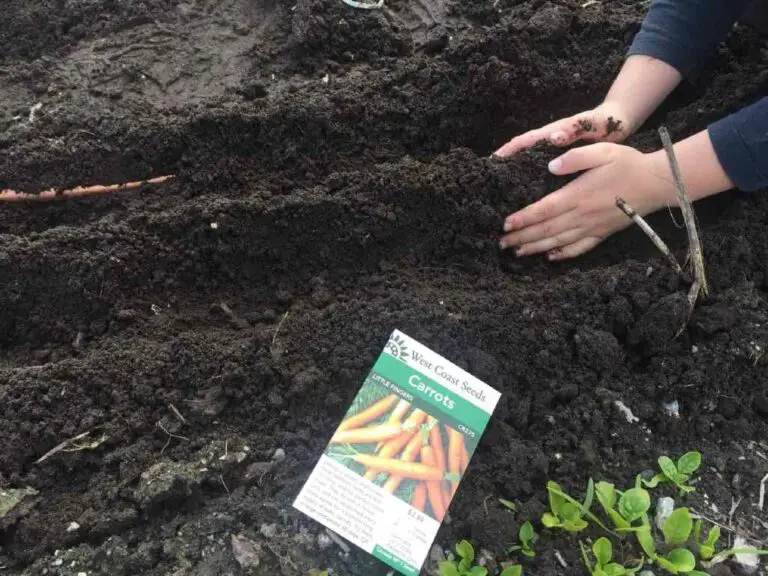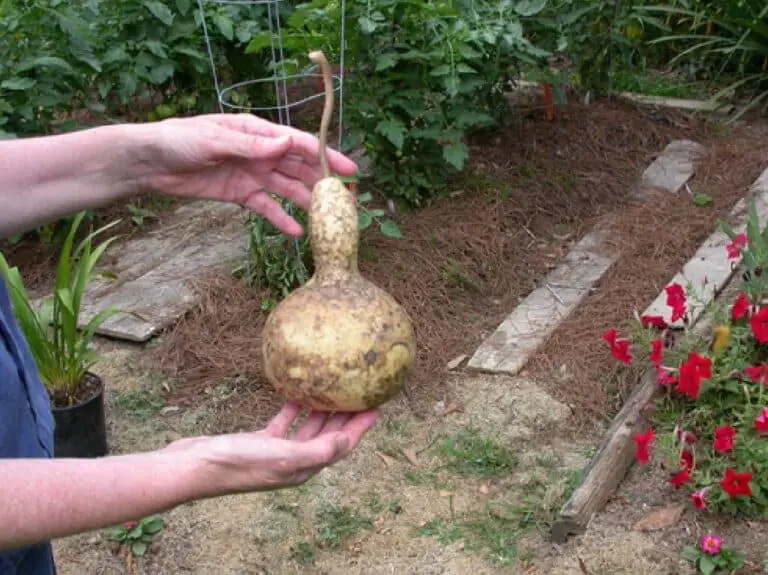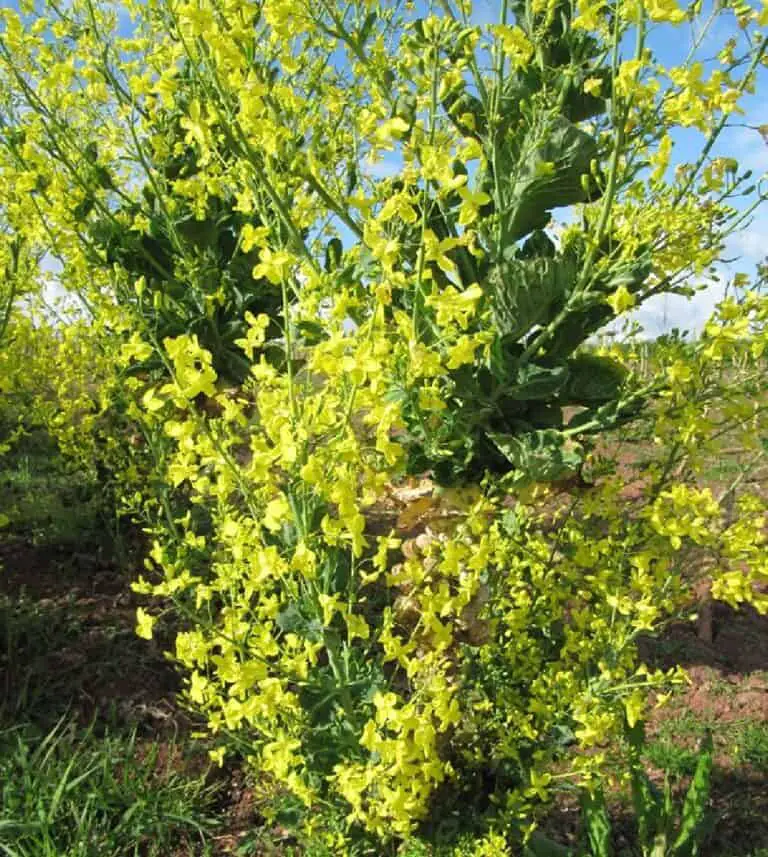Cantaloupe Growing Stages (with Pictures): Plant Life Cycle & Timeline

If you love gardening and want to grow your own fruits, cantaloupes are an excellent choice to add to your garden. These sweet, juicy fruits are perfect for snacking, smoothies, or adding to fruit salads. But growing cantaloupes can be hard because you need to understand the plant’s life cycle and when it grows.
Understanding the cantaloupe plant’s life cycle and schedule is important if you want to give your plants the best chance of growing well. Knowing when to plant the seeds, the best temperature for growth, and how to care for the plant at each stage of its life cycle will help you get the best crop possible.
In this guide, we will take a detailed look at the cantaloupe growing stages, from the seed stage to the post-harvesting stage. This guide will tell you everything you need to know to grow healthy and tasty cantaloupes, from planting the seeds to picking the fruit.
Whether you are a seasoned gardener or a beginner, this guide is perfect for anyone looking to grow this delicious fruit in their backyard. So, let’s dive in and discover the fascinating world of cantaloupe growing stages.
How Long Does It Take for Cantaloupe To Grow?
How long it takes for cantaloupes to grow from seed to harvest is important for making sure the fruit is fully ripe and tasty. Typically, it takes around 80–100 days for cantaloupes to fully grow, but several factors may influence the duration.
The time of year when you plant cantaloupes can also affect their growth rate. Planting cantaloupes in the early spring or summer, when the soil is warm and the air is humid, can help speed up the growth process. The use of fertilizers and other growth-enhancing treatments can also help reduce the time it takes for the cantaloupes to grow and mature.
Factors Affects Cantaloupe Growing
The first factor that affects the growth duration of cantaloupes is the variety of the fruit. The different varieties of cantaloupes have varying growth rates. Some may be faster than others, and vice versa. The plants may also take longer to grow, depending on where cantaloupes are grown. Areas with colder temperatures may take longer to ripen, while areas with warmer temperatures may have a shorter duration.
The second thing that affects how long it takes for cantaloupes to grow is how well they are taken care of while they are growing. For cantaloupes to grow and ripen properly, they need enough water, sunlight, and the right kind of fertilizer.
Cantaloupes may also grow faster and better if they are pruned well and kept free of pests. To shorten the time it takes for cantaloupes to grow, it is important to follow the best practices for growing them.
The way that cantaloupes are picked also affects how long it takes for them to grow. Picking cantaloupes too early may affect the taste and quality of the fruit, while waiting too long may lead to overripening and spoilage. The best way to determine the right time to harvest cantaloupes is by looking at the color, texture, and aroma of the fruit.
When the cantaloupes are fully ripe, the stem should also come off the vine easily. By paying attention to the growth process and following best practices, you can grow delicious and juicy cantaloupes. It may take a little time and effort, but it is undoubtedly worth the wait.
Cantaloupe Growing Stages Life Cycle
1. The Seed Stage

Growing cantaloupes from seed requires patience, care, and attention to detail. The first stage of the cantaloupe’s growing cycle is the seed stage, which is where it all begins. During this stage, the cantaloupe seed is dormant and requires certain conditions to germinate.
The cantaloupe seed has all of the genetic information that will determine what the plant will look like when it grows up. It is important to choose good seeds if you want a healthy plant with traits you like.
The seed coat protects the embryo inside and can be tough, so it is helpful to scarify or nick the seed coat to help the seed absorb water and nutrients more easily. This can be done by using sandpaper or a file to gently scratch the surface of the seed.
Once the seed coat is scratched, the cantaloupe seed is ready to germinate. It needs warm temperatures—around 75 to 80 degrees Fahrenheit—and moist soil to begin sprouting.
If starting the seeds indoors, use a seed-starting mix and keep the soil consistently moist but not waterlogged. It is important to keep the seeds in a warm location, like on top of the refrigerator, to help them germinate. Germination usually takes 7–10 days, and once the seedlings have come up through the soil, they are ready for the next step in the cantaloupe’s growth cycle.
2. Germination Stage

The germination stage is a crucial part of the cantaloupe growing cycle. After the seed stage, the cantaloupe seedling emerges and begins to develop. During the germination stage, the seedling establishes its roots and starts to grow its first true leaves. This stage sets the foundation for the rest of the cantaloupe plant’s growth.
The first thing to consider during the germination stage is the seedling’s environment. The soil should be kept consistently moist but not waterlogged, and the seedlings need a warm, sunny location with good air circulation. If starting seeds indoors, it’s important to make sure they receive enough light to encourage healthy growth. If seedlings are getting too leggy, it might be necessary to adjust the light source or move them to a brighter location.
The germination stage is also a good time for you to start fertilizing the cantaloupe seedlings. A balanced fertilizer, like 10-10-10, can be used to give the seedlings the nutrients they need to grow in a healthy way.
It’s important not to over-fertilize, as this can cause damage to the delicate seedlings. A good rule of thumb is to fertilize once a week with a diluted fertilizer solution, following the instructions on the package.
3. Seedling Stage

After the germination stage, the cantaloupe seedling enters the seedling stage. At this point, the plant has established its roots and is starting to grow its first true leaves. The seedling stage is a crucial stage of growth because the plant is still delicate and requires care and attention to ensure healthy growth.
During the seedling life-cycle, you want to make sure the cantaloupe plant is getting enough light. If growing the plant indoors, provide the plant with plenty of bright, natural light or use artificial grow lights. Cantaloupe plants require at least 8–10 hours of sunlight per day, so make sure to provide enough light to encourage healthy growth.
The seedling stage is also a good time to start thinking about transplanting the cantaloupe plant. Once the seedling has grown its first true leaves and established its root system, it’s ready to be transplanted into a larger container or into the ground. Make sure the new location has good soil that is rich in nutrients and provides good drainage. When transplanting the cantaloupe plant, be careful not to damage the roots, as this can stunt growth or even kill the plant.
4. Vegetative Stage

The vegetative stage is the next stage of the cantaloupe growing cycle. At this point, the plant has developed its root system and its first true leaves and is now focused on growing stems, leaves, and branches. During this stage, the plant grows rapidly, and it’s essential to provide it with the right nutrients, light, and water to support its growth.
During the vegetative stage, giving the cantaloupe plant the right amount of water is one of the most important things to do. While the plant needs regular watering, it’s important not to overwater, as this can lead to root rot or other diseases.
A good rule of thumb is to water the plant deeply once or twice a week, depending on the weather and the soil conditions. It’s also important to ensure good drainage to prevent water from accumulating around the plant’s roots.
During the vegetative stage of its life cycle, giving the cantaloupe plant the right nutrients is another important thing to do. During this stage, the plant needs more nitrogen because it is growing quickly. To give the plant the nutrients it needs, you can use a balanced fertilizer with a high nitrogen content, like a 20-10-10. To keep the plant from getting too much fertilizer, which can hurt it, you must carefully follow the directions on the package.
5. Flowering Stage

The flowering stage is one of the most exciting and important stages of the cantaloupe growing cycle, as it’s when the plant starts to produce its first flowers, which will later develop into fruit. During this stage, the plant needs careful care to make sure it gets the right food, light, and water so it can grow healthy fruit in large quantities.
One critical aspect of the flowering stage is pollination. Cantaloupe plants rely on pollinators such as bees and other insects to pollinate their flowers and help them produce fruit. Without proper pollination, cantaloupe flowers may not produce fruits. It is critical to provide pollinators with a home, such as by planting flowers that bees and other beneficial insects enjoy.
Another important aspect of the cantaloupe flowering stage is providing the plant with the right amount of water. While the plant still needs regular watering, it’s important to avoid overwatering, as this can lead to root rot or other diseases. A good rule of thumb is to water the plant deeply once or twice a week, depending on the weather and the soil conditions. It’s also important to ensure good drainage to prevent water from accumulating around the plant’s roots.
Finally, providing the cantaloupe plant with the right nutrients during the flowering stage is crucial. To help the plant grow flowers and fruit, it needs a balanced fertilizer with less nitrogen and more phosphorus and potassium. It’s important to follow the fertilizer instructions carefully and to avoid over-fertilizing, which can damage the plant and affect its fruit production.
6. Fruit Formation Stage

The fruit formation stage is the most exciting part of the cantaloupe growing cycle, as it’s when the flowers have been pollinated and the fruit starts to form. During this stage, the plant requires careful attention to ensure that it produces high-quality fruit with excellent flavor, texture, and color.
During the stage when the fruit is forming, it is important that the cantaloupe gets enough sunlight so that it can ripen properly. Cantaloupes require a lot of sunshine to develop and ripen. The more sun they receive, the sweeter and more flavorful they will be. Ensure that the plant is in a location that receives at least six hours of direct sunlight each day.
Another essential factor in fruit formation is watering. During the stage when the fruit is growing, it’s important to keep the moisture level steady so that the fruit doesn’t dry out and get a bitter taste. Overwatering can cause cracking and rotting, while not watering enough can make the fruit small or misshapen. It’s best to water the plant deeply once or twice a week, depending on the weather and soil conditions.
Finally, it’s important to monitor the fruit for pests and diseases during the fruit formation stage. Common pests that can attack cantaloupes include aphids, spider mites, and whiteflies. Diseases that can affect cantaloupes include powdery mildew and downy mildew. Check the fruit regularly for signs of infestation or disease, and take appropriate action if necessary to prevent the issue from spreading.
7. Harvesting and Post-Harvesting Stage

To get the best taste, texture, and sweetness from cantaloupes, they must be picked at the right time. The ideal time to harvest cantaloupes is when the stem of the fruit easily separates from the vine with a gentle twist. If the fruit doesn’t come off the vine easily, it may not be fully ripe, and the flavor and sweetness won’t be as good as they could be.
Once harvested, cantaloupes should be stored in a cool, dry place until they are ready to be eaten. If they are not ripe when harvested, they can be left to ripen at room temperature for a few days until they are ready. Cantaloupes should be kept in the fridge once they are ripe. This will help maintain their quality and flavor. They can be stored for up to a week in the refrigerator.
WARNING![]()
Be careful with cantaloupes after they’ve been picked to keep them from getting hurt. Avoid dropping the fruit or handling it too roughly, as this can cause bruising and other damage that can affect the flavor and texture. If the cantaloupe has any cracks or bruises, it’s best to cut them away before eating.
Saving Cantaloupe Seeds for Future Planting
Cantaloupe seeds are incredibly versatile and can be used for planting new cantaloupe crops. Saving the seeds is a great way to make sure that the cantaloupes you grow next year are as good as or even better than the ones you grew last year.
Here is a guide on how to save cantaloupe seeds for future planting:
- The first step in saving cantaloupe seeds is to select a healthy, ripe cantaloupe. The cantaloupe should be fully ripe, and the flesh should be juicy and fragrant.
- Once you have selected the cantaloupe, cut it open and scoop out the seeds.
- Be sure to separate the seeds from the flesh
- Rinse them with water to remove any remaining debris or flesh, and then allow them to dry.
- After the seeds have dried, store them in a cool, dry place. A dry and dark place like a pantry, cupboard, or freezer is an ideal location. It is also advisable to store the seeds in an airtight container or plastic bag to prevent moisture from getting in, which could cause mold or rot.
When you’re ready to plant the saved cantaloupe seeds, ensure that the soil is warm and has a temperature of at least 70°F. Sow the seeds in the soil and cover them with a layer of soil. Water the seeds regularly to keep the soil moist and wait for the seedlings to emerge.
Conclusion
In conclusion, if you want to get a lot of juicy, tasty fruit from your cantaloupes, you need to know how and when they grow. Every part of a cantaloupe’s life cycle is important and needs care and attention, from planting the seeds to picking the fruit. The length of time it takes to grow depends on many things, such as the type of cantaloupe, its location, how it is cared for and maintained, and how it is picked.
By using the best methods for growing cantaloupes, like giving them enough water, sunlight, and fertilizer, and by pruning and getting rid of pests at the right times, you can make sure they grow quickly and healthily. Proper harvesting techniques, like picking the fruit at the right time, can also help keep the fruit’s quality and taste.
Cantaloupe seeds can be saved for planting in the future if you know how cantaloupe grows and how long it lives. By selecting a ripe cantaloupe, separating the seeds, and storing them in a cool, dry, and dark place, you can plant a new crop of cantaloupes and enjoy the fruits of your labor once again.







